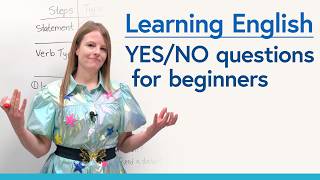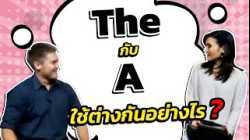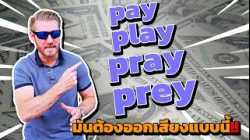
English for Beginners: Learn How to Make YES/NO QUESTIONS สาธารณะ
ประเภท:
ลักษณะ:
Learn the 3 types of yes/no questions in English. I’ll explain each type and show you how to form each of them correctly. You’ll also learn about common mistakes that English learners often make with this type of question, and how to avoid them! At the end of the class, take my quick quiz to test your understanding! Perfect for beginners or anyone who wants to review the basics. Let’s get started! https://www.engvid.com/english-for-beginners-yes-no-questions/
More of my beginner grammar lessons:
Negative Words in English: No, Not, Dont, Didnt https://youtu.be/Jjnl4jGSY_4
Confusing English Grammar: BY or WITH? https://youtu.be/gix9O_sjEzo
In this lesson:
0:00 YES/NO Questions in English
2:27 3 Types of YES/NO Questions
3:12 YES/NO Questions with be
6:26 YES/NO Questions with helping verbs
10:21 YES/NO Questions with main verbs
Transcript:
Hello. My name is Emma, and today, we are going to look at yes/no questions. So, there are six different types of questions in English. Today, we will look at a common type of question, which is the yes/no question. Yes/no questions are answered with yes or no. Many students make mistakes with yes/no questions because they can be a little bit confusing, and Ill show you why. Lets look at some examples.
So, here is a sentence. "She is a teacher." "Is" is the verb. Now, if I turn this into a yes/no question, it becomes, "Is she a teacher?" So, youll notice the "is" and the "she" switched. "Is she a teacher?" "Yes, she is a teacher." Or, "No, she is not a teacher." Both of those are possible answers.
Now, if you look at the next sentence, "You like pizza." If we make this into a question, it becomes, "Do you like pizza?" So, wait a second. "Do you like pizza, but is she a teacher?" These are different. Theyre both yes/no questions, but here we have "do", and in this one, there is no "do". So, today, I will explain why for some yes/no questions we need "do" or "does", and for other yes/no questions, we just do that switch.
Lets look at another example. "They can swim." If we want this to be a yes/no question, it becomes, "Can they swim?" So, in this case, "can" and "they" switch to make a yes/no question, and you will notice we have a question mark, question mark, question mark, so we know its a question. So, lets find out when do we switch, and when do we use "do", "does", and "did".
So, yes/no questions can be confusing because people dont know if they should use "do" or "does" or if they should just switch the verb with the subject. Im going to teach you about three different types of yes/no questions to help you understand this better. So, we have type 1, where were going to talk about the "be" verb; type 2, where were going to talk about helping verbs; and type 3, where were going to talk about main verbs, and Ill explain each of these to you. Understanding the different types will help you create correct yes/no questions.
So, I have here a statement. "She is happy." The first thing you should do when youre creating a yes/no question is you can create a statement, so this is not a question, its like a sentence, and what Im going to do is Im going to think about the verb. The verb in this case is "is". "Is" is a "be" verb, so "be" verbs include "am", like "I am", "are", "you are", "she is", "he is", "it is", "they are", or "we are". So, if you see "are" or "is", youre dealing with the "be" verb. So, this all has to do with the "be" verb. Anytime you have a statement with "is" or "are" like this, and theres no other verb, so as I said, the verb type is the "be" verb, what you do is you switch the position of the subject with the "be" verb. That sounds complicated, but watch. Its very easy. "She is happy." We switch. "Is she happy?" So, we can call this "invert", we can call it "switch". All you do is you take the "is" and you put it in front. "She is happy" becomes "Is she happy?" So, "be" verbs, you invert. You switch the position.
Lets look at some other examples. So, we have here "Are you tired?" So, if we wanted the statement, we could say, "You are tired." Okay? So, "are" is a "be" verb, so the verb type is a "be" verb, so that means its type 1. And so, that means for type 1 verbs, we do the switch. "You are tired" becomes "Are you tired?" And then, of course, the question mark. Okay. So, very easy, you just switch for the "be" verb. Heres another example. "Are kids fun?" So, the statement would be "Kids are fun." "Are" is a "be" verb. You switch them. "Are kids fun?" Or imagine I want to know about your friend. "Your friend is a doctor?" When we switch, it turns to the question, "Is your friend a doctor?" "Be" verbs are the easiest because you just switch the subject with the verb, so the switch is easy. […]
More of my beginner grammar lessons:
Negative Words in English: No, Not, Dont, Didnt https://youtu.be/Jjnl4jGSY_4
Confusing English Grammar: BY or WITH? https://youtu.be/gix9O_sjEzo
In this lesson:
0:00 YES/NO Questions in English
2:27 3 Types of YES/NO Questions
3:12 YES/NO Questions with be
6:26 YES/NO Questions with helping verbs
10:21 YES/NO Questions with main verbs
Transcript:
Hello. My name is Emma, and today, we are going to look at yes/no questions. So, there are six different types of questions in English. Today, we will look at a common type of question, which is the yes/no question. Yes/no questions are answered with yes or no. Many students make mistakes with yes/no questions because they can be a little bit confusing, and Ill show you why. Lets look at some examples.
So, here is a sentence. "She is a teacher." "Is" is the verb. Now, if I turn this into a yes/no question, it becomes, "Is she a teacher?" So, youll notice the "is" and the "she" switched. "Is she a teacher?" "Yes, she is a teacher." Or, "No, she is not a teacher." Both of those are possible answers.
Now, if you look at the next sentence, "You like pizza." If we make this into a question, it becomes, "Do you like pizza?" So, wait a second. "Do you like pizza, but is she a teacher?" These are different. Theyre both yes/no questions, but here we have "do", and in this one, there is no "do". So, today, I will explain why for some yes/no questions we need "do" or "does", and for other yes/no questions, we just do that switch.
Lets look at another example. "They can swim." If we want this to be a yes/no question, it becomes, "Can they swim?" So, in this case, "can" and "they" switch to make a yes/no question, and you will notice we have a question mark, question mark, question mark, so we know its a question. So, lets find out when do we switch, and when do we use "do", "does", and "did".
So, yes/no questions can be confusing because people dont know if they should use "do" or "does" or if they should just switch the verb with the subject. Im going to teach you about three different types of yes/no questions to help you understand this better. So, we have type 1, where were going to talk about the "be" verb; type 2, where were going to talk about helping verbs; and type 3, where were going to talk about main verbs, and Ill explain each of these to you. Understanding the different types will help you create correct yes/no questions.
So, I have here a statement. "She is happy." The first thing you should do when youre creating a yes/no question is you can create a statement, so this is not a question, its like a sentence, and what Im going to do is Im going to think about the verb. The verb in this case is "is". "Is" is a "be" verb, so "be" verbs include "am", like "I am", "are", "you are", "she is", "he is", "it is", "they are", or "we are". So, if you see "are" or "is", youre dealing with the "be" verb. So, this all has to do with the "be" verb. Anytime you have a statement with "is" or "are" like this, and theres no other verb, so as I said, the verb type is the "be" verb, what you do is you switch the position of the subject with the "be" verb. That sounds complicated, but watch. Its very easy. "She is happy." We switch. "Is she happy?" So, we can call this "invert", we can call it "switch". All you do is you take the "is" and you put it in front. "She is happy" becomes "Is she happy?" So, "be" verbs, you invert. You switch the position.
Lets look at some other examples. So, we have here "Are you tired?" So, if we wanted the statement, we could say, "You are tired." Okay? So, "are" is a "be" verb, so the verb type is a "be" verb, so that means its type 1. And so, that means for type 1 verbs, we do the switch. "You are tired" becomes "Are you tired?" And then, of course, the question mark. Okay. So, very easy, you just switch for the "be" verb. Heres another example. "Are kids fun?" So, the statement would be "Kids are fun." "Are" is a "be" verb. You switch them. "Are kids fun?" Or imagine I want to know about your friend. "Your friend is a doctor?" When we switch, it turns to the question, "Is your friend a doctor?" "Be" verbs are the easiest because you just switch the subject with the verb, so the switch is easy. […]
ต่อไป
เล่นอัตโนมัติ










5 ชั่วโมง